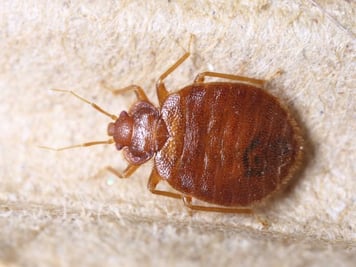Checking Out the Science Behind Bed Insect Heat Treatments as a Sustainable Pest Administration Strategy
In the world of pest administration, the quest for effective and sustainable remedies stays a consistent pursuit. One such approach that has acquired grip over the last few years is using warmth treatments to battle bed insect infestations. By taking advantage of the scientific research behind thermal death points for these relentless pests, warm therapies offer an appealing choice to traditional chemical-based methods. The details of how warm successfully removes bed bugs and the wider ramifications for lasting pest management methods make this a subject worth discovering better.
Bed Pest Warmth Therapy Refine

Thermal Fatality Point for Bed Pests
Subjecting bed bugs to raised temperature levels beyond their thermal resistance range is critical for accomplishing reliable elimination in heat therapy processes. The thermal death factor for bed bugs describes the temperature at which these bugs can not survive. Research study shows that bed insects start to perish when revealed to temperatures above 113 ° F(45 ° C) for a continual period. As the temperature level raises, so does the mortality price of bed pests. At around 118 ° F(48 ° C ), bed bugs start to pass away rapidly, with a mortality price of nearly 99% within minutes of direct exposure. This shows the sensitivity of bed insects to heats and highlights the effectiveness of warm therapies in eradicating invasions. By reaching and preserving temperature levels over the thermal fatality point for bed bugs, bug monitoring professionals can guarantee detailed removal of bed pest populations, including hard-to-reach areas where chemical treatments might be much less reliable. Recognizing the thermal death point for bed bugs is vital for applying effective warmth therapy strategies and achieving sustainable insect administration end results.
Advantages of Heat Treatments
Having actually established the crucial thermal death factor for bed pests, it is necessary to currently explore the significant advantages that my latest blog post heat treatments provide in effectively eliminating these resilient pests. When contrasted to conventional chemical methods, heat therapies present several crucial advantages. One of the key advantages is that heat can penetrate deep right into splits and crevices where bed insects hide, ensuring that also one of the most hard-to-reach areas are heated up to deadly temperature levels. This extensive method not just kills real-time bugs yet also targets bed pest eggs, protecting against future invasions.
Additionally, warm therapies are eco friendly and non-toxic, making them a sustainable bug monitoring strategy. Unlike chemical pesticides, heat treatments do not leave damaging deposits that can present threats to human wellness or the setting. This aspect is particularly important in sensitive environments such as medical facilities, institutions, and property locations where chemical usage may not be desirable.
Furthermore, warm treatments have a high success rate in eliminating bed bug infestations in a solitary therapy, lowering the demand for several sees and decreasing disturbance to passengers. This effectiveness not only saves money and time yet additionally supplies peace of mind to those handling bed bug problems.
Performance of Warm Treatment

Warmth therapies have actually the added benefit of killing bed insect eggs, which are commonly immune to traditional chemical treatments. In general, the efficiency of warm therapies in getting rid of bed pest infestations makes them a sustainable and trustworthy parasite monitoring approach.
Lasting Pest Administration Conveniences
Applying lasting bug administration practices offers lasting advantages for both the atmosphere and public health. By utilizing approaches such as warm treatments for pest control, we can lower the dependence on damaging chemical pesticides that can have unfavorable effects on ecosystems and human wellness - bed bug heat treatment. Sustainable pest monitoring techniques help in maintaining biodiversity by targeting particular pests without damaging non-target organisms, thereby keeping a balanced ecological community
Moreover, sustainable bug management techniques add to the total health and health of the public. By decreasing exposure to poisonous chemicals used in typical pest control approaches, heat therapies provide a more secure option for insect monitoring in domestic, industrial, and public spaces. This reduction in chemical usage also assists in protecting against chemical residues from contaminating water, soil, and air, safeguarding environmental top quality.
Conclusion
To conclude, bed insect heat treatments have been shown to be a effective and lasting pest monitoring technique. The thermal death factor for bed pests makes them susceptible to warmth treatments, which have various benefits over traditional chemical therapies. The performance of warm treatments in getting rid of bed pest problems while lessening ecological effect highlights the potential of this technique as a sustainable remedy for insect control.
The bed bug warmth treatment process includes elevating the temperature within plagued areas to a level that successfully removes bed bugs and their eggs. By getting to and keeping temperatures above the thermal fatality directory point for bed bugs, pest monitoring specialists can make sure comprehensive removal of bed insect populaces, consisting of hard-to-reach locations where chemical treatments might be less reliable. One of the main benefits is that warm can permeate deep into fractures and crevices where bed insects hide, making sure that also the most hard-to-reach locations are warmed to deadly temperatures. Unlike chemical treatments that may leave behind immune populations, heat treatments supply a non-toxic and environmentally friendly solution that can permeate deep right into furnishings, wall surfaces, and other hard-to-reach locations where bed insects conceal.
The thermal fatality factor for bed insects makes them vulnerable to heat therapies, which have countless advantages over typical chemical therapies.